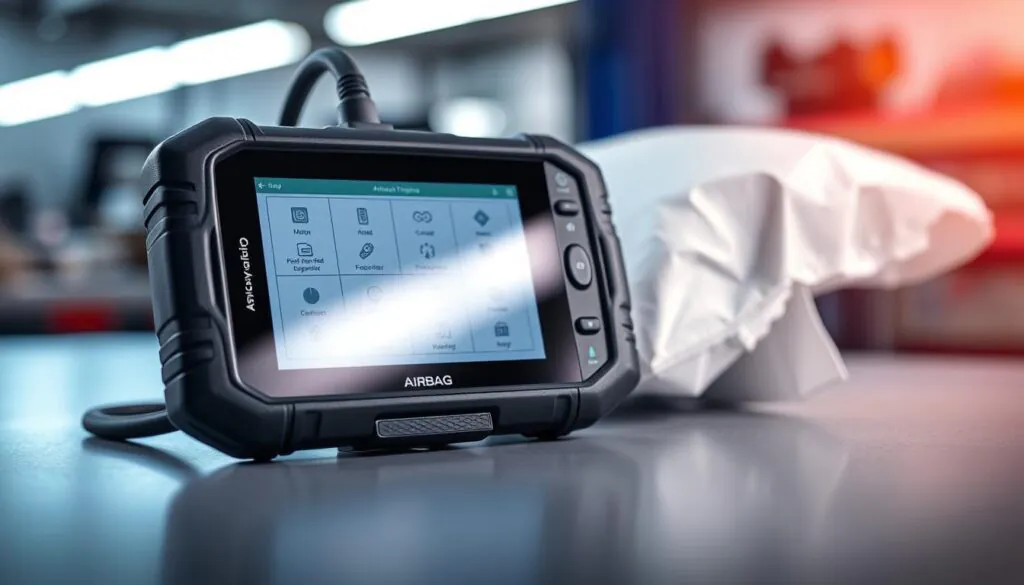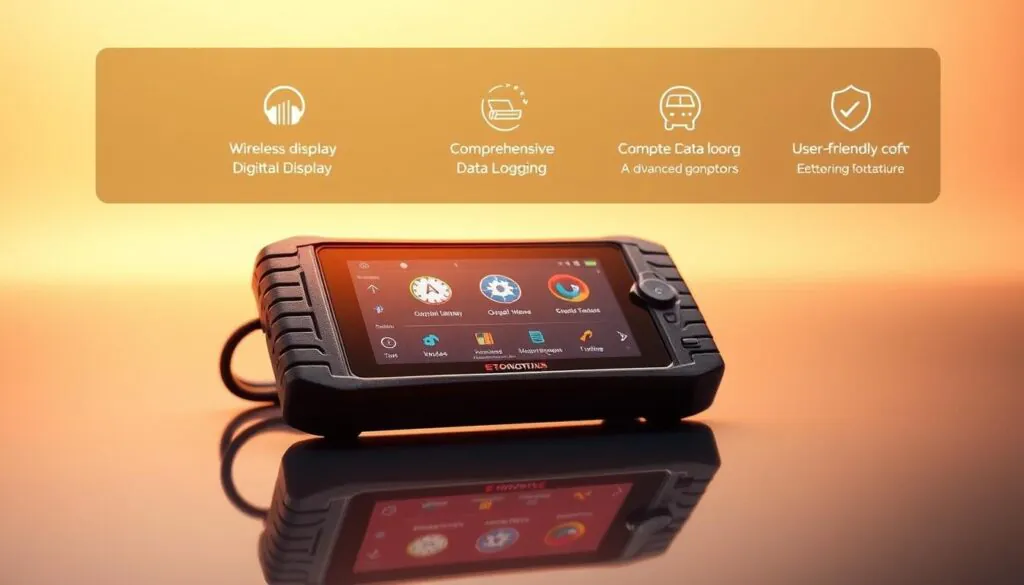Alright, let’s chat about that little light staring at you from the dashboard – the airbag or SRS warning light. Seeing it flash on can definitely make your heart skip a beat, right? Now, your standard OBD2 scanner is awesome for checking out engine or transmission troubles, but it usually gets stumped when it comes to your car’s safety systems. Specifically, it often can’t decode what’s happening with the Supplemental Restraint System (SRS) – the system that controls your airbags.
That’s exactly where a specialized tool comes in handy: the airbag code reader.
Think of an airbag code reader as a more advanced diagnostic gadget built specifically to talk to complex systems like the SRS. Why’s this important? Because your SRS is critical – it ensures your airbags deploy properly if you’re ever in a crash. When that warning light stays on, it means there could be a serious issue that a basic scanner just won’t see. A dedicated airbag code reader pulls the specific fault codes, helping you or your mechanic figure out the exact problem.
Using the right airbag code reader isn’t just about turning off an annoying light; it’s about making sure your car is genuinely safe to drive. Whether you’re a pro mechanic working on cars all day or just someone trying to keep your own vehicle safe, knowing how to use an airbag code reader for accurate diagnostics is super important.
Quick Guide: Key Things to Know
- You really need a specific airbag code reader to diagnose SRS system issues.
- Regular OBD2 scanners usually can’t read airbag fault codes; an airbag code reader is the right tool for the job.
- Tools like the Foxwell NT716 are examples of effective airbag code readers that can dive deep into SRS diagnostics.
- Getting accurate readings from your airbag code reader is vital for your car’s safety.
- Using an airbag code reader for proper diagnosis helps fix problems faster and keeps you safer on the road.
What’s an Airbag Code Reader Anyway?
A persistent warning light on your dash isn’t just a nuisance; it could be waving a red flag about a safety risk. When it’s the light for your Supplemental Restraint System (SRS), you absolutely shouldn’t ignore it. Your everyday OBD2 scanner, while great for engine codes, often can’t communicate with the SRS. This is precisely why the specialized airbag code reader was created!
Let’s Break Down What an Airbag Code Reader Does
An airbag code reader is essentially a specialized diagnostic tool designed to communicate directly with your car’s SRS module. Unlike those basic scanners, it digs into the airbag system to pull detailed error information. This lets you identify and address problems that standard tools would likely miss entirely. A good airbag code reader translates complex system data into fault codes you can understand.
Most standard OBD2 scanners just aren’t built to interpret SRS codes, making a dedicated airbag code reader pretty much essential for these kinds of issues. These tools provide the precise information needed to diagnose that warning light. Brands like Foxwell make devices that serve as reliable airbag code readers, ensuring compatibility with your vehicle.
Why You Really Need a Specialized Airbag Code Reader
These specialized scanners often do more than just read codes. Many advanced airbag code readers come packed with useful features like firmware updates (keeping the tool current with newer car models) and other enhanced functions, such as streaming live data from sensors. This makes them incredibly valuable for both professional mechanics and DIY car enthusiasts.
Understanding the fault codes pulled by your airbag code reader is crucial for maintaining your car’s safety. When you know exactly what a code signifies, you can arrange for repairs promptly, preventing potential hazards. With the right airbag code reader, you gain peace of mind, knowing your car’s safety systems are functioning as they should.
Bottom line: a quality airbag code reader delivers the accuracy and reliability required to tackle SRS issues confidently. Whether you repair cars professionally or in your own garage, investing in a proper airbag code reader is a smart decision for safer driving.
Using Your Airbag Code Reader to Diagnose Problems
Your car is trying to communicate, especially when that airbag light refuses to turn off. Don’t ignore it! A persistent warning light usually indicates an issue within your car’s Supplemental Restraint System (SRS). Diagnosing the problem requires the right tool – your airbag code reader – and following the correct steps.
Identifying Airbag Warnings & Connecting Your Reader
First things first: pay attention to the signs. That illuminated airbag light on your dashboard is the primary indicator. Unlike some other warning lights, this one typically stays on until the underlying issue is resolved. Here’s what you should do:
- Start your car. Does the airbag light remain lit? If yes, it’s time to investigate.
- Get your specialized airbag code reader (remember, standard OBD2 readers usually won’t cut it here). Plug it into your car’s OBD2 port to retrieve the fault codes.
- Codes like B1100 or B1102, identified by the airbag code reader, often indicate specific issues, such as problems with sensors or wiring within the SRS.
Decoding the SRS Diagnostics from Your Airbag Code Reader
Once your airbag code reader is securely connected (usually to the OBD2 port located under your dashboard), it’s time to delve deeper. Advanced tools, like the Foxwell NT716 (which functions as an excellent airbag code reader), offer a comprehensive view of the SRS. Here’s how to interpret the information provided by your airbag code reader:
- Examine the live data stream displayed by the airbag code reader. This can help identify sensor issues happening in real-time.
- Look up the specific codes your airbag code reader found in your vehicle’s service manual. This ensures you understand precisely what the code means for your particular car.
- Always double-check the information your airbag code reader provides to ensure you haven’t overlooked any crucial details.
Understanding the diagnostic results from your airbag code reader is vital. Accurate diagnosis leads to faster, more effective repairs and ensures your car’s safety systems are ready to protect you when needed most.
Step-by-Step: How to Scan & Reset Airbag Codes
When that airbag light is persistently glowing on your dash, it’s signaling that something needs attention. A light that doesn’t turn off often points to an issue with the Supplemental Restraint System (SRS). Addressing these problems requires careful handling and the right tool – specifically, a reliable airbag code reader. Here’s a simple guide to help you manage the situation safely.
Preparing Your Car and Airbag Code Reader
First, find a safe, level spot to park your car. Turn the engine completely off, then turn the ignition key to the “on” position (so the dashboard lights come on, but the engine doesn’t start). Make sure you have your airbag code reader (confirm it’s compatible with your car’s SRS system) and your vehicle’s service manual handy.
Next, locate the OBD2 port. You’ll typically find it under the dashboard on the driver’s side, often near the steering wheel or pedals. Plug your airbag code reader cable firmly into the port – you should feel or hear it click securely into place.
Reading Codes and Clearing Faults Safely
With the airbag code reader connected, power it on. Navigate through its menu options until you find the selection for the SRS or airbag system. Initiate the scan sequence. The airbag code reader will then communicate with the SRS module and retrieve any stored fault codes.
These codes pinpoint the problem – it could be anything from a faulty impact sensor to an issue with the clock spring in your steering column. Use your car’s service manual to understand the exact meaning of each code reported by the airbag code reader.
This is Crucial: Before you even think about using your airbag code reader to clear the codes, you MUST fix the actual problem that triggered the code in the first place! Simply clearing the code without performing the necessary repair is dangerous because it means your airbags might not deploy correctly in an accident. Once the repair is successfully completed, you can then use the airbag code reader’s reset or clear codes function.
After clearing the code, immediately run another scan with your airbag code reader to confirm the code doesn’t reappear instantly. Then, take your car for a short test drive (about 10 minutes should do) to ensure the airbag light stays off and the system is functioning properly.
“Correctly diagnosing and resetting codes with an appropriate airbag code reader ensures your vehicle’s vital safety systems are operational and ready to protect you. Always adhere to your car manufacturer’s specific guidelines for the best and safest results.”
| Step | Action | Details |
|---|---|---|
| 1 | Prep Tools & Car | Have your airbag code reader and service manual ready. Park safely, ignition ‘on’ (engine off). |
| 2 | Find OBD2 Port | Locate the port, usually under the driver’s side dashboard. |
| 3 | Scan for Codes | Connect the airbag code reader, select the SRS/Airbag system menu, and initiate the scan to read codes. |
| 4 | Understand Codes | Use the vehicle service manual to interpret the meaning of the codes found by the airbag code reader. |
| 5 | Fix & Reset | Repair the identified underlying issue FIRST. Then, use the airbag code reader to clear the fault codes. |
| 6 | Verify Fix | Run another scan with the airbag code reader to ensure codes are gone. Perform a test drive (approx. 10 mins) to confirm the light stays off. |
Following these steps carefully allows you to properly maintain your car’s safety systems using an airbag code reader. Always prioritize safety when working on the SRS. If the light comes back on, or if you’re ever unsure about a repair, it’s always wisest to consult a qualified professional mechanic.
Going Deeper: Advanced Airbag Code Reader Features & Tips
Modern cars are incredibly complex, especially their safety systems. Knowing how to maintain these systems is crucial. Good airbag code readers offer much more than just basic code retrieval; they often include advanced features that aid in precise diagnosis and effective repairs, ensuring your car’s safety mechanisms are always ready.
Beyond Basics: Enhanced Diagnostics & Firmware Updates
Some sophisticated diagnostic tools, which function as powerful airbag code readers, might boast features like bi-directional control or even ECU programming capabilities. So, what’s bi-directional control? It means the airbag code reader can send commands *to* your car’s systems, not just passively read data. This is incredibly useful for testing components actively. For instance, you could command a specific airbag sensor to trigger and then observe if the system responds correctly, all monitored through your airbag code reader.
Keeping your airbag code reader’s firmware up-to-date is also vital. Regular updates ensure the tool remains compatible with the latest vehicle models and often introduce new diagnostic functions or expand vehicle coverage. Reputable brands like Foxwell typically provide ongoing updates for their tools, maximizing their effectiveness as an airbag code reader.
Best Practices: Using Your Airbag Code Reader Safely and Effectively
Safety first, always! Ensure your car is parked securely with the ignition ‘on’ (but engine off) before connecting your airbag code reader. Follow the tool’s instructions meticulously to avoid inadvertently disrupting your car’s electronic system.
Be mindful of legal requirements as well. In many regions, critical safety systems like airbags must be fully operational to pass vehicle inspections. Using an airbag code reader merely to reset a warning light without actually fixing the underlying fault is unsafe and could lead to legal issues or inspection failure. Always repair the problem, confirm the fix worked (re-scan with your airbag code reader and perform a test drive), and ensure the warning light remains off.
- Choose an airbag code reader with a user-friendly interface, particularly if you’re new to automotive diagnostics. Clear menus and easy navigation make a big difference.
- Stay on top of firmware updates! This practice keeps your airbag code reader accurate and extends its useful life across more vehicles.
- Always cross-reference fault codes retrieved by the airbag code reader with your vehicle’s specific service manual. Re-scan after repairs to verify success.
By adhering to these tips, you can confidently ensure your car’s safety systems are maintained correctly. An advanced airbag code reader not only simplifies diagnostics but ultimately contributes to a safer driving experience for you and your passengers.
Summing Up: Why a Good Airbag Code Reader Matters
Let’s be real – ensuring your car’s safety systems are in top shape isn’t just nice-to-have, it’s essential. Using a professional-grade diagnostic tool, specifically a capable airbag code reader (like the Foxwell NT716 mentioned earlier), is fundamental for accurately diagnosing SRS problems. Unlike basic OBD2 scanners, these specialized tools are designed to communicate deeply with the Supplemental Restraint System, enabling you to pinpoint and correctly resolve issues. An effective airbag code reader is indispensable for this crucial task.
Remember, the goal isn’t just to switch off a warning light; it’s about leveraging your airbag code reader to identify and rectify the root cause of the problem. Features like live data streaming and consistent firmware updates ensure these tools remain effective for complex modern vehicles. Performing regular checks with your airbag code reader and keeping the tool updated are critical steps for maintaining vehicle safety.
By investing in and properly utilizing a quality airbag code reader, and by following expert guidance and safety procedures, you can drive with greater confidence, knowing your vehicle’s critical safety system is prepared to function correctly if ever needed. Always prioritize accurate diagnosis and safety first when dealing with SRS components!
Frequently Asked Questions (FAQ) about Airbag Code Readers
What exactly is an SRS system, and why do I need a special airbag code reader for it?
The SRS, or Supplemental Restraint System, includes your car’s airbags and seatbelt pretensioners – key safety components. Standard OBD2 scanners usually can’t ‘speak the language’ of the SRS module to read its specific error codes. That’s why you need a dedicated airbag code reader to diagnose problems and make sure everything is working right.
Can’t I just use my normal OBD2 scanner instead of buying an airbag code reader?
Most likely, no. Standard OBD2 scanners are primarily designed for engine and emissions-related codes (like the Check Engine Light). To accurately read and clear airbag fault codes (related to the SRS warning light), you almost always need a specialized airbag code reader built for SRS diagnostics.
How do I know if I actually need to use an airbag code reader?
The biggest clue is the airbag warning light staying illuminated on your dashboard after you start the car. If that light stays on, it means the system has detected a fault. To find out the specific reason the light is on, you’ll need an airbag code reader to pull the diagnostic trouble codes (DTCs) from the SRS module.
Is it safe for me to reset airbag codes myself using an airbag code reader?
You can, but ONLY if you have the correct type of airbag code reader *and* you have completely fixed the underlying problem first! Never, ever use an airbag code reader just to turn off the light without making the necessary repairs. Doing so is extremely unsafe because it could mean your airbags won’t work in an accident. Always fix the problem before resetting the code!
What features should I look for when buying an airbag code reader?
Make sure the airbag code reader specifically states it supports SRS/airbag system diagnostics for your car’s make, model, and year. Useful features include live data streaming (to see sensor readings in real-time), the ability to both read *and* clear codes, ease of use (clear screen, intuitive menus), and the availability of regular firmware updates from the manufacturer. Choosing a reputable brand usually ensures a more reliable airbag code reader.
Where is the port to plug in the airbag code reader?
The airbag code reader connects to the OBD2 (On-Board Diagnostics II) port. In most vehicles, this port is located under the dashboard on the driver’s side, often near the steering column, kick panel, or above the pedals. If you have trouble finding it, your car’s owner’s manual should show its exact location.
Can a good airbag code reader check other parts of my car too?
Yes, definitely! Many devices sold as or including airbag code reader functions are actually multi-system scan tools. These more advanced tools can often diagnose issues in other major systems like the engine (Check Engine Light codes), transmission, ABS (anti-lock braking system), and sometimes even climate control or body electronics. This makes them very versatile tools for overall vehicle maintenance and troubleshooting.


